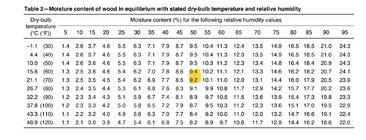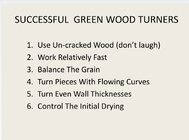I have been sealing the full inside and outside with Pva glue. I know it’s not necessary so I would like to know what I really need to do. Do I just seal the end grain on the outside of bowl and not put any seal in the inside?
-
November 2025 Turning Challenge: Wall Hanging! (click here for details) -
Congratulations to Craig Morton, People's Choice in the October 2025 Turning Challenge (click here for details) -
Congratulations to Andy Chen for "Mesquite Vase with Polymer Clay Millefiori" being selected as Turning of the Week for November 3, 2025 (click here for details) -
Welcome new registering member. Your username must be your real First and Last name (for example: John Doe). "Screen names" and "handles" are not allowed and your registration will be deleted if you don't use your real name. Also, do not use all caps nor all lower case.
You are using an out of date browser. It may not display this or other websites correctly.
You should upgrade or use an alternative browser.
You should upgrade or use an alternative browser.
Sealing first turned bowls
- Thread starter Barry Holman
- Start date
If you want to use a sealer, yes the inside end grain needs to be sealed. PVA glue is a good choice, as is PVA based primer, usually a bit cheaper.
I prefer using paper bags. It’s a lot less time and mess, and the bags can be reused many times
I prefer using paper bags. It’s a lot less time and mess, and the bags can be reused many times
Okay, so, are these twice turned bowl blanks and you have removed most of the bulk? There are hosts of sealers out there for rough turned bowl blanks. PVA glue actually works really well since it breathes, and water can escape. If you are twice turning your bowls, do make sure to round over the rim, both inside and outside since a sharp edge can cut you, and a sharp rim is far more likely to crack since there are limits to how tall of a bowl you can make. You want even wall thickness, but when you come to the rim, there is no more wall, and rounding over the rim eases the stress that a sharp edge makes. Outside end grain especially needs to be sealed, and inside grain doesn't hurt to seal that either.
robo hippy
robo hippy
Man! I got a response from Robo Hippy! I am honored! I will start sealing end grain on the inside and outside.
Wait one. There are many different 'systems' used by turners to dry rough turned bowl blanks. It's kind of like witchcraft.
There are a number of variables that affect the rate of drying and chance of cracking. Important to me, as I live in an arid place, is the ambient humidity. Yours will be different than mine, or Reed's, or Doug's. Where will these be sitting while they dry? (Attics are hot and dry, basements are cool and wet. Shops are all over the place. Garages have a variable climate due to seasons, presence of heat or not.) What wood are we talking about? (Aspen, and mesquite from what I hear, move very little and are less likely to crack. Fruit wood cracks before the toppled tree hits the ground.) ETC.
I don't want to make this vastly more complicated than it needs to be. Talk with local turners in your area and see what methods work for them. Try some of those methods. Eventually, you will figure out what will work for you.
Personally, I coat the outside, but not the inside, of the roughed blank, put in a paper sack, and place on a wire rack (which allows air circulation), with the open end of the bowl down, in my basement where the temperature year round is most stable. Your mileage WILL vary.
There are a number of variables that affect the rate of drying and chance of cracking. Important to me, as I live in an arid place, is the ambient humidity. Yours will be different than mine, or Reed's, or Doug's. Where will these be sitting while they dry? (Attics are hot and dry, basements are cool and wet. Shops are all over the place. Garages have a variable climate due to seasons, presence of heat or not.) What wood are we talking about? (Aspen, and mesquite from what I hear, move very little and are less likely to crack. Fruit wood cracks before the toppled tree hits the ground.) ETC.
I don't want to make this vastly more complicated than it needs to be. Talk with local turners in your area and see what methods work for them. Try some of those methods. Eventually, you will figure out what will work for you.
Personally, I coat the outside, but not the inside, of the roughed blank, put in a paper sack, and place on a wire rack (which allows air circulation), with the open end of the bowl down, in my basement where the temperature year round is most stable. Your mileage WILL vary.
Odie
Panning for Montana gold, with Betsy, the mule!
Okay, so, are these twice turned bowl blanks and you have removed most of the bulk? There are hosts of sealers out there for rough turned bowl blanks. PVA glue actually works really well since it breathes, and water can escape. If you are twice turning your bowls, do make sure to round over the rim, both inside and outside since a sharp edge can cut you, and a sharp rim is far more likely to crack since there are limits to how tall of a bowl you can make. You want even wall thickness, but when you come to the rim, there is no more wall, and rounding over the rim eases the stress that a sharp edge makes. Outside end grain especially needs to be sealed, and inside grain doesn't hurt to seal that either.
robo hippy
I have a question concerning the notion that rounding over the edge prevents cracking that originates with a sharp corner.
For years, I've followed this practice of rounding the corner, but sometimes I forget to do this. In all this time, I've never noticed a crack that originated from a sharp edge intersection of two planes.
So....has this particular issue been problematic for other turners?
Note: I will continue the practice of rounding over the corner because it's so easy and quick to do, and besides, it does eliminate a sharp edge that can be dangerous......but, are we concerned about a problem that may be nonexistent?
=o=
Last edited:
Odie
Panning for Montana gold, with Betsy, the mule!
As for sealing roughed bowls, I'm a believer in sealing the entire bowl with a wax emulsion sealer I've sourced from CSUSA for the past 40 years. It does breathe, so it successfully slows down the rate of moisture loss.....and, that's exactly what you want. The slower the seasoning process, the fewer stress cracks you will have.....it's that simple! 
When it comes to seasoning a roughed bowl......time is your friend! With that in mind, the best way to have as few problems as possible, a turner needs to have many bowls drying at a time. When the monthly weights stabilize.....the MC has stabilized to it's own environment. (This is an important consideration, as @Dean Center appropriately suggests above in post #5.)
With many bowls in the seasoning process at any given time, along with monthly logged weights, the choice of which bowl to 2nd turn next becomes much less problematic for a bowl turner.
=o=


When it comes to seasoning a roughed bowl......time is your friend! With that in mind, the best way to have as few problems as possible, a turner needs to have many bowls drying at a time. When the monthly weights stabilize.....the MC has stabilized to it's own environment. (This is an important consideration, as @Dean Center appropriately suggests above in post #5.)
With many bowls in the seasoning process at any given time, along with monthly logged weights, the choice of which bowl to 2nd turn next becomes much less problematic for a bowl turner.
=o=


Odie, the concept of trying to keep an even wall thickness is pretty well understood. But, what happens when you get to the rim? I round over the rims for safety sake so I don't slice myself, which I have done a few times, as well as on boards that have been hand planed run through the drum sander. Those edges can be very sharp. Also, and I have had this happen a number of times, with sloppy wet wood especially, if you leave that sharp edge, you get uneven drying at that point which creates stress, and as we all know, wood relieves stress by cracking. Hope that makes sense.
robo hippy
robo hippy
I seal the outside of the bowls with an end sealer sold by Lee Valley. My limited experience with fresh-cut oak however, means that I'll never turn the damn stuff again!
I’ve always sealed the inside and outside completely (I use anchorseal) then store on a shelf in my cool basement. I’ve never had a bowl crack, though I’ve only just started twice-turning and coring the last couple years and have only done around 50-75 bowls. That may also have to do with the type of wood available to me - mostly cottonwood and elm with some maple and sycamore too.
I’m curious how many people only seal the end grain with success as this would save anchorseal which isn’t cheap (I buy 5 gallons at a time for around $100 and it lasts me several years).
Thanks, tom
I’m curious how many people only seal the end grain with success as this would save anchorseal which isn’t cheap (I buy 5 gallons at a time for around $100 and it lasts me several years).
Thanks, tom
- Joined
- Apr 27, 2004
- Messages
- 9,295
- Likes
- 6,045
- Location
- Lakeland, Florida
- Website
- www.hockenberywoodturning.com
I have been sealing the full inside and outside with Pva glue. I know it’s not necessary so I would like to know what I really need to do. Do I just seal the end grain on the outside of bowl and not put any seal in the inside?
Successful drying begins with even wall thickness and nice curves followed with slow drying in an appropriate environment.
Pva or anchor seal will slow the drying nicely
I switched to paper bags less mess and bowls dry a few months faster.
I use bags in pairs with one over the open end of the other.
Every day for about 5 days I swap the damp bags for dry ones. The damp bags will dry overnight.
If I see any mold on a bowl during the damp bag stage I wipe the bowl with Clorox and discard the bags it came out of.
After a few days usually less than 5 the bags won’t feel damp and I put the bagged bowl on a shelf
In about 8 months take the bowl out of the bag and let dry on a shelf.
My drying room has a dehumidifier set at 50%. My wood will dry to about 9% and the returned bowl will not warp because that environment is similar to most homes with controlled environments. Air dry a bowl in a humid environment to 20%MC it will loose another 10%MC and warp in the average home.
This is an air drying chart from the forestry service. The drying environment determines how dry a bowl will be at equilibrium.
My bowls will be a little over 9%.

A slide from a demo I do

